旅游英语教程 修月祯主编 第01章
- 格式:ppt
- 大小:768.00 KB
- 文档页数:29
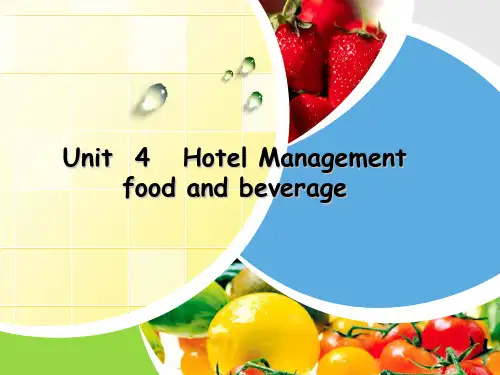

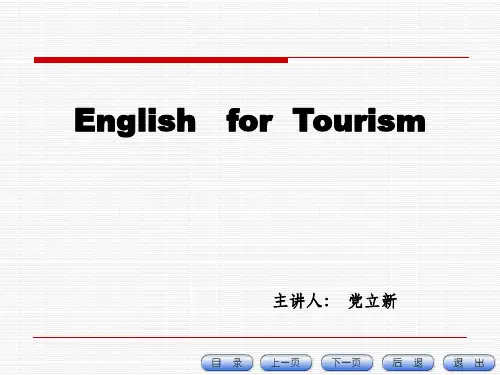
![旅游专业英语(第四版)第一章教案 (2)[4页]](https://uimg.taocdn.com/3edb275526284b73f242336c1eb91a37f011324b.webp)
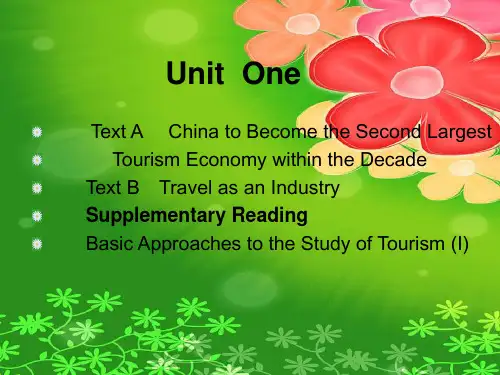
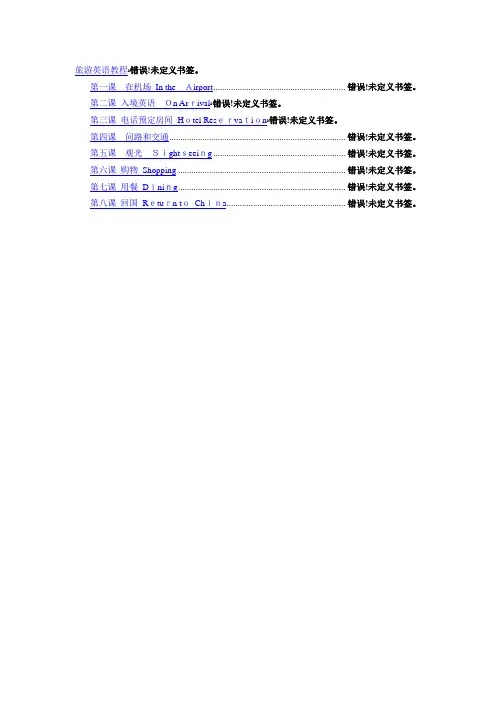
旅游英语教程ﻩ错误!未定义书签。
第一课在机场In theAirport............................................................ 错误!未定义书签。
第二课入境英语On Arrivalﻩ错误!未定义书签。
第三课电话预定房间Hotel Reservationﻩ错误!未定义书签。
第四课问路和交通................................................................................ 错误!未定义书签。
第五课观光Sightseeing ............................................................ 错误!未定义书签。
第六课购物Shopping ............................................................................ 错误!未定义书签。
第七课用餐Dining............................................................................ 错误!未定义书签。
第八课回国Return toChina...................................................... 错误!未定义书签。
第一课在机场In the Airport需要帮忙吗?May Ihelp you?我要办理此次班机的登机手续。
I'dlike to check in for this flight, please.请把行李放在磅秤上。
Please put yourluggage onthis scale.你需要在柜台托运你的行李。
You need to claimyour baggage at the counter. 我可以把这件行李随身带到飞机上吗?Can I take this oneas carry-on baggage?班机准点吗?Is theplaneon schedule?可否给我靠窗的座位?/靠走道的座位?Could I getawindowseat?/an aisle seat?登机门是几号?Whatis the gate number?登机门怎么走?Whichway to the gate?你将在旧金山机场转机。
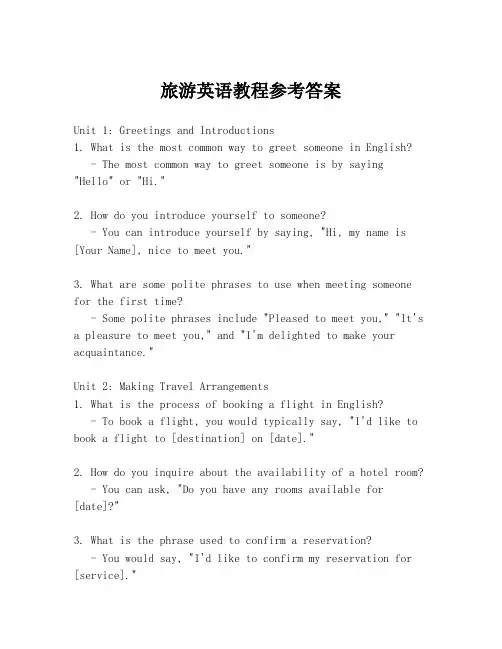
旅游英语教程参考答案Unit 1: Greetings and Introductions1. What is the most common way to greet someone in English? - The most common way to greet someone is by saying "Hello" or "Hi."2. How do you introduce yourself to someone?- You can introduce yourself by saying, "Hi, my name is [Your Name], nice to meet you."3. What are some polite phrases to use when meeting someone for the first time?- Some polite phrases include "Pleased to meet you," "It's a pleasure to meet you," and "I'm delighted to make your acquaintance."Unit 2: Making Travel Arrangements1. What is the process of booking a flight in English?- To book a flight, you would typically say, "I'd like to book a flight to [destination] on [date]."2. How do you inquire about the availability of a hotel room? - You can ask, "Do you have any rooms available for [date]?"3. What is the phrase used to confirm a reservation?- You would say, "I'd like to confirm my reservation for [service]."Unit 3: At the Airport1. What do you say when you need to check in for a flight?- You would say, "I'd like to check in for my flight to [destination]."2. How do you ask for directions to the gate?- You can ask, "Excuse me, could you please direct me to gate [number]?"3. What is the phrase used to request assistance with luggage? - You can say, "Could you help me with my luggage, please?"Unit 4: On the Plane1. How do you ask for a blanket or pillow?- You would ask, "Excuse me, could I get a blanket and a pillow, please?"2. What do you say if you need to use the restroom?- You can say, "Excuse me, where is the restroom, please?"3. How do you request a beverage or snack?- You would say, "Could I have a [beverage or snack], please?"Unit 5: At the Hotel1. What is the phrase used to check into a hotel?- You would say, "I have a reservation for [your name],I'd like to check in."2. How do you ask about the hotel's amenities?- You can ask, "What amenities does the hotel offer?"3. What do you say if you need to request extra towels?- You would say, "Could I get some extra towels, please?"Unit 6: Dining Out1. How do you ask for a table at a restaurant?- You would say, "Do you have a table for [number of people]?"2. What is the phrase used to request the menu?- You can ask, "May I see the menu, please?"3. How do you order a meal in English?- You would say, "I'd like to order [dish name], please."Unit 7: Sightseeing1. How do you ask for directions to a tourist attraction?- You can ask, "Could you tell me how to get to [attraction]?"2. What is the phrase used to buy a ticket for a tour?- You would say, "I'd like to buy a ticket for the [tour name]."3. How do you inquire about the operating hours of a museum? - You can ask, "What are the opening hours of the museum?"Unit 8: Shopping1. How do you ask for the price of an item?- You would ask, "How much does this cost?"2. What is the phrase used to negotiate a price?- You can say, "Could you give me a discount?"3. How do you ask for a receipt?- You would say, "May I have a receipt, please?"Unit 9: Emergency Situations1. How do you ask for help in an emergency?- You would say, "I need help, this is an emergency!"2. What is the phrase used to call for medical assistance? - You can say, "I need a doctor, please!"3. How do you report a lost item?- You would say, "I've lost my [item], can you help me find it?"Unit 10: Cultural Etiquette1. How do you show respect for local customs?- You can say, "I am here to learn about and respect your customs."2. What is the phrase used to apologize for a cultural mistake?- You can say, "I apologize。
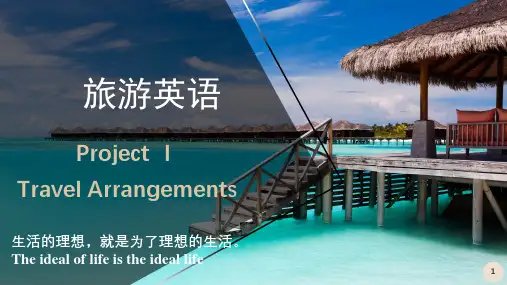
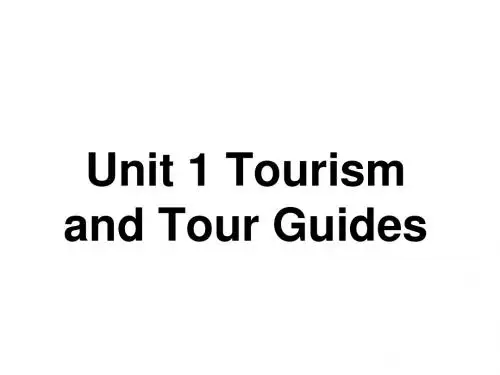
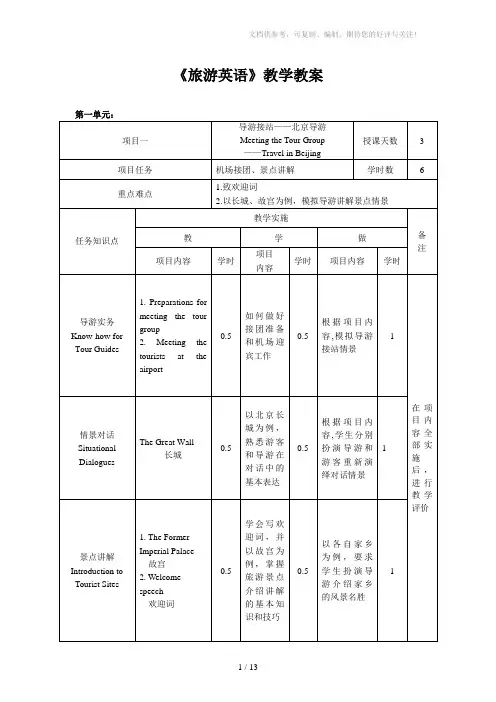

《旅游英语》课程标准一、课程性质与任务《旅游英语》课程是旅游管理专业的一门专业必修课。
通过本课程的学习,使学生具有一定的运用英语进行交际的综合能力,特别是听说能力,达到从事一般旅游业所需的英语水平。
使学生熟悉入境涉外旅游和出境旅游方面的工作流程与规范,掌握各工作流程的英语交际会话,掌握旅游专业词汇和旅游英语特定的表达方式,能与外国游客进行日常口语的对话,能用英语为外国游客简单地介绍相关旅游景点及文化专题,能带旅游团进行出境旅游,提高学生的职业素质和英语素质。
二、课程教学目标本门课的教学目标体系主要有知识,能力、素质三大目标体系。
其三大目标体系关系包括:语言知识的传授:语言知识向语言技能的迁移;学生自主学习、发散性思维以及职业素质的培养。
(一)知识目标掌握有关旅游服务接待中常用的专业词汇,了解旅游英语口语的特定表达方式;(二)能力目标加强角色扮演旅游情景对话的训练,提高听说能力,能较流利地与外国游客进行交流。
(三)素质目标通过在不同场合中导游活动的演练,熟悉导游工作程序,提高学生综合运用英语和旅游专业知识的能力。
三、参考学时56学时四、课程学分2学分五、课程内容和要求六、教学建议(一)教师任职条件大学本科及以上学历,英语专业。
遵纪守法,品行端正,热爱教育事业。
身体健康,五官端正,普通话标准,适应岗位要求的身体条件。
(二)教学方法建议主要采用情景法、交际法、讨论法、任务法、差合法五种教学方法。
在教学过程中,有目的地引入或创设具有一定情绪色彩的、形象生动、具体的场景,从而引起学生一定的态度体验,从而帮助学生掌握知识,从而使学生的心理机能得到发展。
如:在安排日程表这一具体场景,应有目的地引入航线飞行时间安排日程表,让同学们采用任务法设计飞机航线飞行时间安排日程表,并采用交际法让同学们角色扮演,用英语沟通交流购买某一航线飞行时间安排日程表中的航班机票。
通过这种方法,激发了学生的情感,引起了学生一定的态度体验,从而掌握了航空服务售票环节应用英语语言的应用与练习差合法是此门课程具有特色的教学方法与手段。
旅游英语培训教程(doc 9页)旅游英语教程 (1)第一课在机场In the Airport (1)第二课入境英语On Arrival (2)第三课电话预定房间Hotel Reservation .. 3第四课问路和交通 (4)第五课观光Sightseeing (5)第六课购物Shopping (6)第七课用餐Dining (6)第八课回国Return to China (7)passengers to board.敬请各位旅客注意,这是登机前的广播。
May I have your attention, please? This is the pre-boarding announcement.谨代表华航欢迎您搭乘202从中国北京前往美国克里夫兰的班机。
我们的飞行时间是14小时又30分。
机长Lyon与我将为您服务。
基于安全理由,起飞与降落时期禁止使用电子设备。
谢谢您的合作。
请系好安全带。
On behalf of China Airlines, we welcome you aboard flight No.202 from Beijing, China to Cleveland. Our flying time is 14 hours and 30 minutes. Captain Lyon and I will be at your service. For safety reasons, the use of personal electronic devices is prohibited during take-off and landing. Thanks for your cooperation. Please fasten your seat belt.机上服务:需要报纸吗?Would you like a newspaper?可否把椅背扶直?Could you put your seat up, please?要鸡肉还是牛肉?Would you like fish or beef?请你把袋子放在上头的柜子里。
旅游英语选读讲义旅游英语选读课程概述一、课程性质和学习目的“旅游英语选读”是高等教育自学考试英语专业中的一门选修课,是专门为提高自学应考者的语言水平和旅游知识水平而设置的。
随着旅游业的蓬勃发展,越来越多的人投身于这项事业。
旅游业,作为一个涉及面极广的产业,要求从业人员不但具有较高的外语水平,而且具备丰富的旅游专业知识。
为了帮助英语专业自学应考者更好地掌握英语知识和旅游专业知识,本书课文主要选自国外最新旅游教科书和国外报刊杂志,难度适中,力求在巩固已学过的英语知识的基础上,扩大旅游专业词汇,提高英文阅读与翻译能力。
自学应考者通过学习这些优秀的旅游英语文章,不仅能掌握旅游基本知识,而且对现代旅游、旅游业、旅游的作用于影响及世界旅游现状有所了解,为将来在旅游行业中从事业务工作、管理工作和开展科研工作打下良好的基础。
按照本大纲设定的考核知识点和考核要求认真学习,对自学应考者顺利通过本课程的考试会有极大的帮助。
二、有关能力层次要求的说明为了使个人自学、社会助学和考试命题有统一而明确的目标可循,本大纲更可能将考试内容落实到具体的考核点,对考核点的能力程度要求分为两个层次:记忆,了解。
记忆主要指的是:有关旅游的术语、主要概念和定义、重点词汇的运用等。
了解,主要指的是:课文的重要内容,要求考生在了解的基础上,掌握内容大意,并能用自己的语言表达出来。
三、关于自学教材《旅游英语选读》(全国高等教育自学考试指导委员会办公室组编)修月祯主编,高等教育出版社,1999四、关于自学方法(一)认真领会大纲。
鉴于自学者受学习条件的限制,通常缺乏教师当面、及时的辅导,在大纲中,明确规定了本课程的考试内容和考核目标,以及命题比例和试题题型。
因此,在学习课文前,首先阅读大纲,认真领会其内容,做到以大纲为指导自学的准则。
(二)采取灵活的学习方法。
《旅游英语选读》在编写过程中,遵循了旅游专业的一般性知识体系,因而具有较强的系统性和概括性。
旅游英语教材大学旅游英语教材旅游英语教材大学Chapter 1: Introduction to Travel EnglishIn this chapter, we will introduce the basics of travel English. You will learn essential phrases and vocabulary for traveling, such as greetings, asking for directions, and ordering food in English-speaking countries.Section 1: Greetings and Small Talk- Introduce common greetings in English, including "Hello," "Good morning/afternoon/evening," and "How are you?"- Teach students how to respond to greetings and engage in small talk.Section 2: Asking for Help and Directions- Provide phrases and vocabulary for asking for help and directions, such as "Excuse me, can you help me?" and "Where is the nearest bus stop?"- Introduce common prepositions used in giving directions, such as "left," "right," "straight," and "around the corner."Section 3: Ordering Food and Drinks- Teach students how to order food and drinks in English-speaking restaurants. Include phrases like "I would like..." and "Could I have the menu, please?"- Introduce common food and beverage vocabulary, such as "appetizer," "main course," "water," and "coffee."Chapter 2: Travel Planning and BookingIn this chapter, we will focus on travel planning and booking procedures. Students will learn how to make reservations, book transportation, and arrange accommodation in English-speaking countries.Section 1: Making Reservations- Teach students how to make hotel and restaurant reservations over the phone or online.- Provide vocabulary and phrases for specifying check-in/check-out dates, room preferences, and dietary restrictions.Section 2: Booking Transportation- Introduce vocabulary and phrases for booking flights, trains, buses, and taxis.- Teach students how to inquire about schedules, prices, and availability.Section 3: Arranging Accommodation- Provide information on different types of accommodation, such as hotels, hostels, and vacation rentals.- Teach students how to inquire about room availability, amenities, and rates.Chapter 3: Traveling and SightseeingIn this chapter, we will cover topics related to traveling and sightseeing. Students will learn how to navigate transportation systems, ask for recommendations, and express their preferences.Section 1: Using Public Transportation- Introduce vocabulary and phrases for using public transportation, such as buses, trains, and subways.- Teach students how to ask for directions to specific landmarks or attractions.Section 2: Asking for Recommendations- Provide vocabulary and phrases for asking locals for recommendations on places to visit, restaurants to try, and activities to do.- Teach students how to express their preferences and seek information about opening hours and entry fees.Section 3: Describing Tourist Attractions- Teach students how to describe tourist attractions in English, using appropriate adjectives and expressions.- Provide vocabulary for discussing historical sites, natural wonders, and cultural landmarks.Chapter 4: Communication and Cultural AwarenessIn this chapter, we will focus on improving communication skills and developing cultural awareness in a travel context.Section 1: Overcoming Language Barriers- Provide strategies for overcoming language barriers when traveling, such as using visual aids, gestures, and simple English phrases.- Teach students how to politely ask for clarification and confirm understanding.Section 2: Cultural Dos and Don'ts- Introduce cultural differences and norms in English-speaking countries.- Teach students about etiquette, customs, and gestures to avoid cultural misunderstandings.Section 3: Dealing with Emergencies- Teach students essential English phrases for dealing with emergencies, such as seeking medical help or reporting lost belongings.- Provide information on emergency services and resources available in English-speaking countries.Conclusion:By the end of this textbook, students will have acquired practical travel English skills for communicating in various travel situations. They will be prepared to interact confidently with English speakers during their travels and have a better understanding of cultural nuances.。